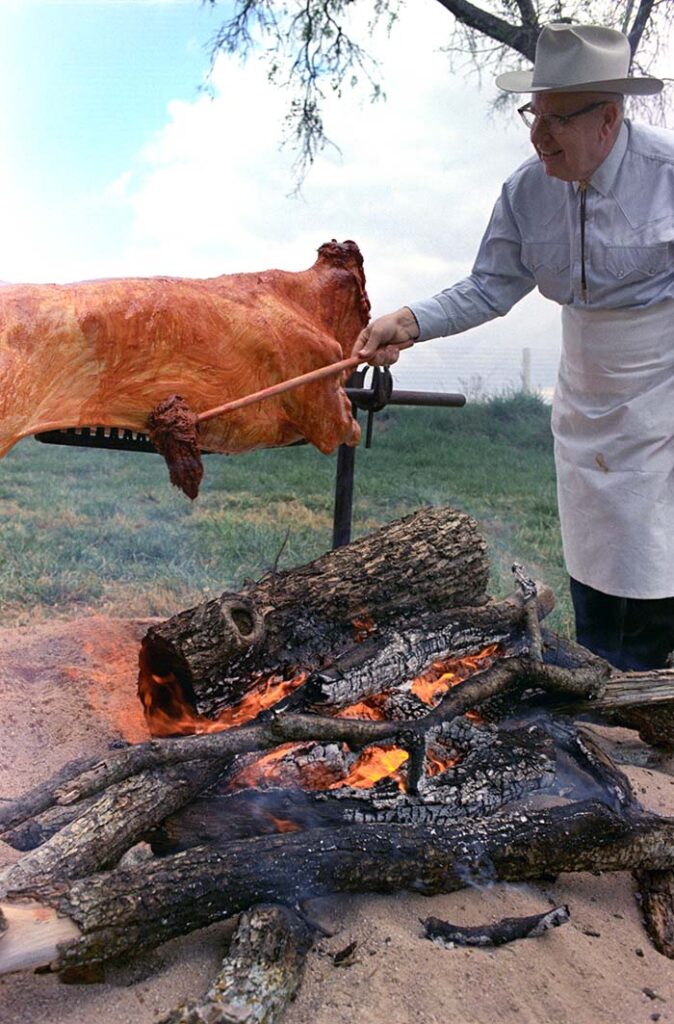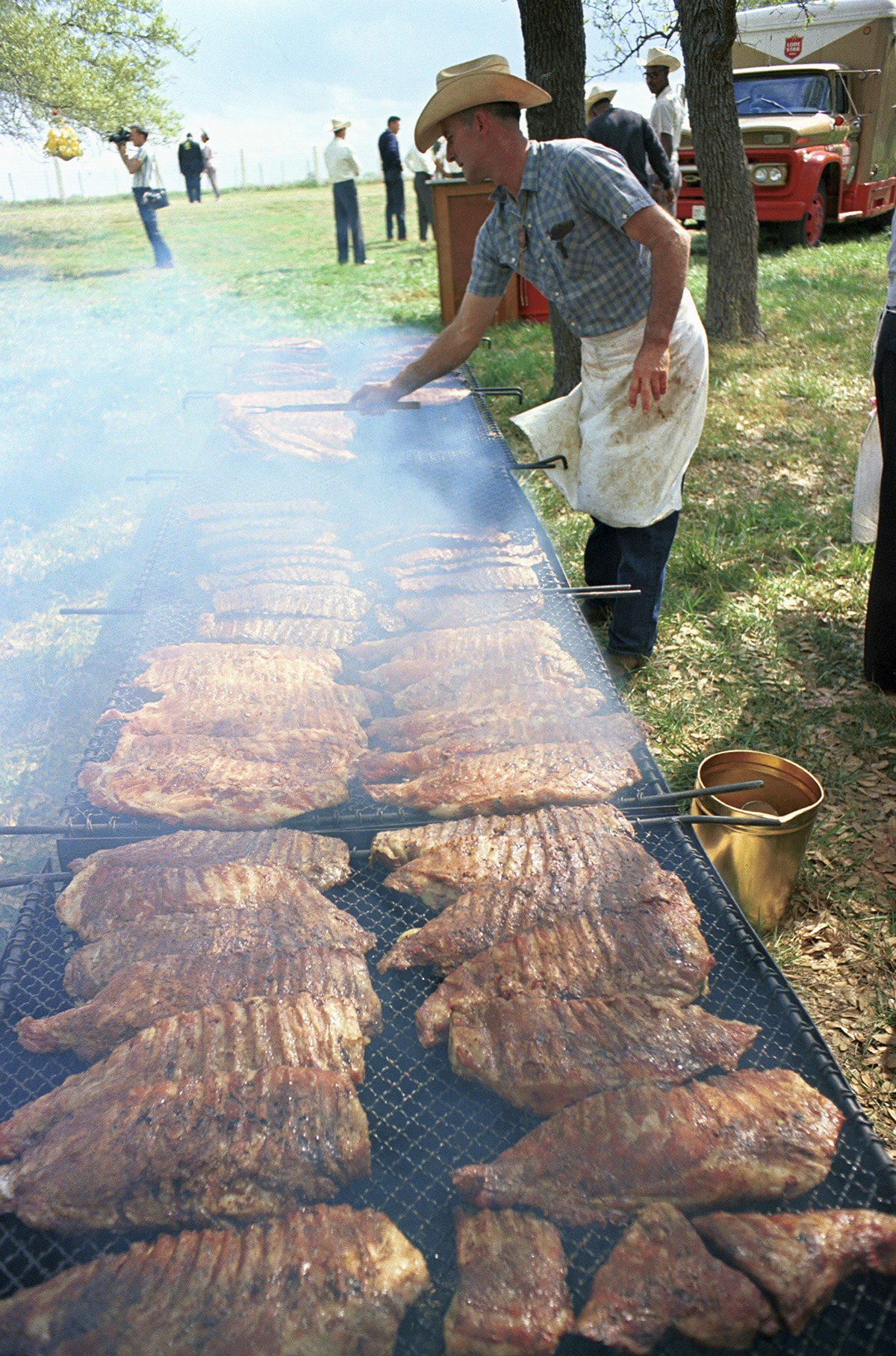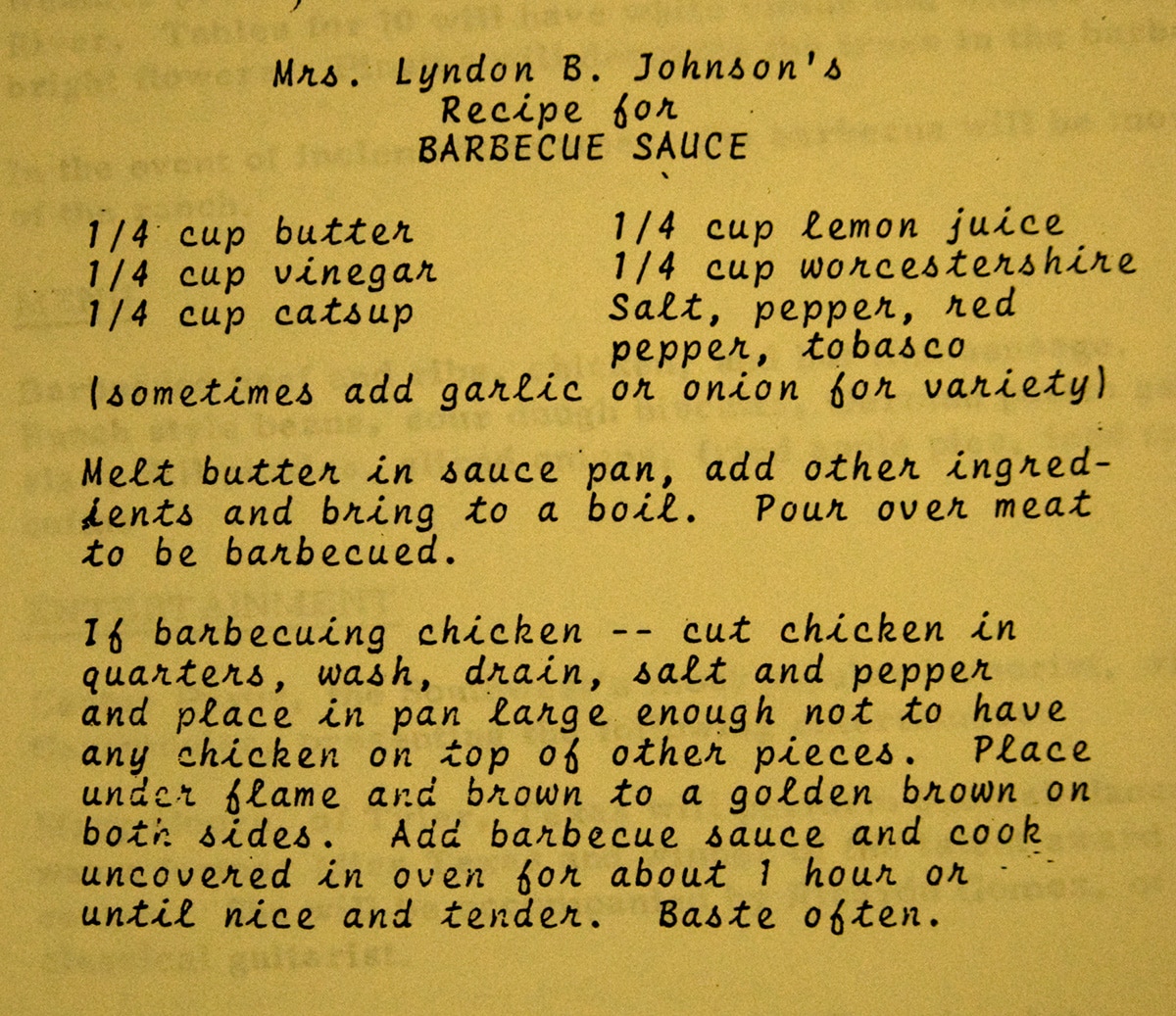Barbecue has been used as a tool in American political campaigns for more than a century, and will no doubt be employed extensively again this summer. Even notable politicans such as John McCain have been known to brag about their skill with the grill. But no politician ever used the conviviality and informality of cooking and eating outdoors more effectively than the 36th President, Lyndon Baines Johnson, who stepped away from the Oval Office in 1969.
The rolling Hill Country west of Austin, TX, is inelegant, rocky, dusty, tangled with brush and prickly pear cactus, cloven occasionally by meager stream beds that lie dry and barren much of the year. There are few cattle because there is little grass and less water to sustain them, but there are plenty of tarantulas, scorpions, horned toads, and barbecue pits.
Johnson emerged from this terrain molded by it: Craggy, unadorned, complex, and formidable. Although he rose to the Presidency, he remained rooted in Texas, and used his LBJ Ranch and the barbecue skills of Walter Jetton to achieve political ends.

In 1950, the former school teacher and his wife, Lady Bird, bought a parcel on the banks of the lazy Pedernales River (pronounced PERD-nah-less) just west of his boyhood home in Johnson City. The modest ranch became an integral part of the image he wanted to project in Washington. Rich Texans all had ranches. He was not rich, but his wife had an inheritance that she had parlayed into a tidy sum by buying a radio station in Austin.
It was also a place to retreat, relax, and recuperate from the pace of the Washington. He often invited constituents, donors, politicians, and staff to the LBJ Ranch. When they arrived he would show them his spread, often on horseback. The visits were opportunities for LBJ to parlay with his guests man to man as they passed across the pastures, returned to the ranch house for bull sessions, then a barbecue, and an overnight stay. The intimacy was politically effective.
As his political career progressed, the barbecues got bigger and more elaborate, and as more important guests came to Hill Country, Lady Bird undertook the first of several remodeling plans to host them in style. Eventually the ranch would include several guest suites, a swimming pool, a radio tower, and an airstrip capable of handling small jets.

In October 1959, as Majority Leader of the Senate and candidate for the Democratic Presidential nomination, he hosted his first big barbecue, for his friend, Mexican President Lopez Mateos. Among the guests were his father’s old friend, Speaker of the House Sam Rayburn, and former President Truman, a man LBJ admired greatly. It was a great success, politically and socially. Even Truman wrote to compliment his host.
John F. Kennedy, the charismatic young senator from Massachusetts, thwarted Johnson’s nomination attempt, but he invited the powerful Senator from the South to run for Vice President on his ticket. They won a close campaign against Richard Nixon and Henry Cabot Lodge, in 1960.
In April 1961, the new Vice President hosted a barbecue for West German Chancellor Konrad Adenauer. The American West held a romantic appeal to Europeans, and the attraction was greater to Adenauer because Hill Country had been settled by many German families. According to Hal K. Rothman, author of the book LBJ’s Texas White House, “The American West and its ranching, its barbecues, beans, and chuck wagons, had a cross-cultural resonance that allowed even those raised in other parts of the world to participate in an American myth made universal by popular fiction and the movies. Foreigners could see their preconceived vision of the ‘real America’ in the vistas, settings, entertainment, and libations of the LBJ Ranch. For Europeans, this was all especially poignant; it resonated with the myths they held about the American West. Adenauer’s visit began a universalization of the ranch, its transformation from a place of continental iconography to one of international symbolic meaning.”
Later that year Field Marshall Mohammed Ayub Khan of Pakistan was feted at the ranch. Khan deftly averted a diplomatic incident by ignoring the fact that pork ribs were served. Pork is forbidden to Muslims. But a connection was made between men of rocky soil and poor farmers. Khan later became President of Pakistan.
The most important barbecue ever planned for the LBJ Ranch never happened. It was scheduled for November 23, 1963, when the Vice President, the President, and their entourages were planning to dine beneath the oaks on the Pedernales. But a few hours before they were to board the choppers from Dallas to Johnson City, on November 22, Kennedy was assassinated two cars in front of Johnson as they drove in a motorcade. Instead of taking his boss for a tour around his spread and feeding him barbecue, Johnson found himself back in Washington attending memorial services, and meeting with the cabinet, leaders of Congress, and former Presidents Eisenhower and Truman.

A month later, frazzled from, as Ladybird described it, the “tornado of activity that has surrounded us”, the Johnson family retreated to the ranch on Christmas Eve. West German Chancellor Ludwig Erhard was scheduled to visit the President to discuss the Soviet threat, the Berlin Wall, and other important matters. Rather than return to Washington for a formal State Dinner, Lyndon invited Erhard and his entourage on down to what historians claim was the first official Presidential barbecue in history. Yes, Johnson’s first state dinner was a barbecue for 300 catered by Walter Jetton on December 29, 1963.
When his staff realized it would be chilly that day, the sit-down part was moved indoors to Stonewall High School gymnasium, about two miles away. Workers did an admirable job of creating an outdoorsy feel with bales of hay, red lanterns, red-checkered table cloths, saddles, lassos, and mariachis. According to Lady Bird’s diary, “there were beans (pinto beans, always), delicious barbecued spareribs, cole slaw, followed by fried apricot pies with lots of hot coffee. And plenty of beer.” Jetton’s famous six-shooter coffee was also served, a brew that one Texan said is “so strong it will float a .44.” The food was served on paper plates, buffet style.
The President’s aides wanted to add some sophistication to the event, so they got the world’s most famous pianist, another Texan, Van Cliburn, to play classical music. Erhard presented Johnson with a bottle of 1959 Piesporter Goldtrsÿpchen Feinste SpSÿtlese by Reichsgraf von Kesselstatt, a superb sweet white wine. Johnson presented Erhard and his entire delegation with Stetsons.
Richard “Cactus” Pryor, a Texas humorist and KTBC employee, was master of ceremonies at this and several other barbecues. Pryor jokingly apologized to the German delegation because they could not find a recipe for barbecued sauerkraut.
Johnson’s cookouts strove for authenticity with “the look and feel of a chuck wagon dinner” said Pryor. Unfortunately that included cowpies that the Air force was asked to remove. For future events it was decided that the cattle should be kept on the south side of the river.
Johnson began spending more and more time on the ranch. In his five years in office he flew in 74 times and spent 490 days there, almost 25% of his term. The phrase “barbecue diplomacy” was coined by W. D. Taylor of The New York Herald-Tribune. Johnson liked the symbolism. It conveyed the sense of an everday man as President, the same image conveyed by Truman. It was so effective the Johnsons occasionally staged barbecues at the White House, also a first.
During the Presidential election campaign of 1964, Johnson flew Jetton around the nation to cook at political rallies. After a Jetton campaign barbecue at Gracie Mansion, New York City’s mayoral residence, Brendan Gill wrote in the New Yorker “Barbecues as a symbol compare favorably with the 1952 hole in Adlai Stevenson’s shoe.”

Johnson and Minnesota Senator Hubert H. Humphrey won the election over Barry Goldwater and William E. Miller with the greatest popular vote in history up to that time, and 61% of the votes.
Shortly after the election, Johnson staged an impromptu Victory Barbecue at the Ranch on November 4, 1964. He and Humphrey hosted the White House press corps as guests of honor.
The two dressed in western suits and Stetsons, rode horses, and ate ribs for the cameras. Jetton later wrote in his cookbook that Humphrey “sure gave these ribs a fit… He went at them like Clyde Beaty to cats and must have eaten them for an hour, putting away more of them than I have ever seen anybody do. So far as I could tell, they did him no harm.”
One of the largest barbecues was on April 1, 1967, with 35 Latin American ambassadors and their wives. There was a huge re-enactment of the settling of Texas by Native Americans, followed by Spaniards, then Anglo cowboys, complete with buckboards and cattle. Johnson spoke briefly of his War on Hunger and he pledged three million tons of food grain to India and another $25 million in food for distribution by CARE. After all the guests left, he demonstrated his penchant for micromanagement by telling Social Secretary Bess Abell that “The food needed to be hotter in the future.” It is unclear if he meant chili pepper or thermal heat. But in the next few moments he demonstrated his leadership. When told that Congressman Gonzales was unhappy because so many Republicans had been invited to the barbecue, Johnson replied that he was “President of all the people, Republicans and Democrats.”
Other noteworthy events in LBJ’s career
Lyndon Baines Johnson was born in 1908, the first of five children. His father, Sam Ealy Johnson Jr., was a farmer who got himself elected to the state legislature. His mother, Rebekah Baines, was well read and taught elocution from their modest frame home. There was no electricity and Sam’s attempts at growing cotton didn’t work out so well.
Young Lyndon grew to 6’3″, graduated from Southwest Texas State Teachers’ College in 1931, became a teacher in a poor Mexican community and then taught debate at a Houston high school. He caught the eye of Texas Democratic Congressman Richard Kleberg who hired him to work in DC. On a trip home he also caught the eye of Claudia Alta Taylor, known to her friends as “Lady Bird”. They were married seven weeks after they met, in 1934.
Lady Bird played a vital part in LBJ’s career with support, advice, and money. Lady Bird had degrees in history and journalism from the University of Texas. In 1943, with money she inherited, she bought a struggling low power, daytime radio station in Austin. KTBC eventually grew to include AM, FM, and TV operations, and her ventures grew to include other broadcast interests, banks, and real estate. Her money helped pay for the LBJ Ranch and Lyndon’s campaigns. She remained active in the LBJ Holding Company well into her 80s.
The gregarious young Lyndon was elected to Congress as a Democrat in 1937 at age 28. In 1948 he was elected to the Senate. Within three years Johnson had risen to Minority Whip for the Democrats in the Senate, a bottle-rocket ascent.
Congressman Johnson was appointed Lieutenant Commander in the U.S. Naval Reserve in 1940 and after Pearl Harbor he was the first member of Congress to volunteer for active duty in the armed forces, reporting on December 9, 1941, two days after the bombing. Johnson was awarded a Silver Star for his service in the Pacific.
Senate Majority Leader Johnson guided the passage of Civil Rights Act of 1957, the first civil rights bill in 82 years.
After the 1957 launch of the Russian satellite, Sputnik, as Chairman of the Senate Preparedness Investigating Subcommittee, he prodded the US space program by launching hearings. A year later he was influential in the formation of NASA, and as VP he was Chairman of the Space Council. He advised President Kennedy that a trip to the moon was possible, and as a result Kennedy made it a national goal. Johnson’s involvement in the space program was pivotal in the construction of NASA’s center in Houston, now named the Johnson Space Center.
As President, in 1964, he said “The Great Society rests on abundance and liberty for all. It demands an end to poverty and racial injustice, to which we are totally committed in our time.” These became the themes of his presidency as he championed education bills, anti-poverty programs, Medicare, urban renewal, conservation, consumer protection, crime prevention, beautification, and the arts.
Among his proudest moments was when he signed the Civil Rights Act of 1964 which insured access to public accommodations and authorized withholding of federal funds from programs deemed discriminatory. It was followed by the Voting Rights Act of 1965.
In 1966 his youngest of two daughters, Luci, was married in DC, and in 1967 his oldest daughter, Linda, was married in the East Room.
His legacy of domestic accomplishments was overshadowed by his escalation of the Vietnam War. He increased troop presence in Vietnam and bombed North Vietnam. The growing unpopularity of the war, and especially the draft, would eventually destroy much of his popularity. On March 31, 1968, the man who became President in 1963 after an assassination and was elected by a record margin in 1964, announced he would not run for re-election. His Vice President, Hubert H. Humphrey, ran in his stead and lost to Richard Nixon by less than 1% of the popular vote.
Lyndon Johnson died at his ranch at 64 on January 22, 1973 from a heart attack. Lady Bird died at 94 on July 11, 2007. The LBJ Ranch is now the Lyndon B. Johnson National History Park and much of the property has been renovated and preserved, and is open to the public. Click here for more about the lives and careers of LBJ and Lady Bird.
Lady Bird’s Barbecue Sauce
Lady Bird Johnson enjoyed handing out her recipe for barbecue sauce, similar to Jetton’s (above), but simpler. Source: LBJ Library & Museum.

Sources
No news, just ribs at McCain barbecue – CNN.com, March 4, 2008.
Entertaining in the White House – By Marie Smith, 1967, Acropolis Books.
LBJ’s Texas White House, Our Heart’s Home – By Hal K. Rothman, 2001, Texas A&M University Press.
Mrs. Johnson built business empire but looked out for people – By Lori Hawkins, Austin American-Statesman, July 16, 2007
The Presidents’ Cookbook – By Poppy Cannon & Patricia Brooks, 1968, Funk & Wagnalls.
TIME Magazine, 2/9/1968.
Ruffles and Flourishes – By Liz Carpenter, 1970, Doubleday & Co.
Walter Jetton’s LBJ Barbecue Cookbook – By the Caterer to the LBJ Ranch, Written with Arthur Whitman, 1965, Pocket Books.
A White House Diary – By Lady Bird Johnson, 1970, Trafalgar Square.
The White House Family Cookbook – By Harry Haller with Virginia Aronson, RD, MS, 1987, Random House.
LBJ Library & Museum Online and numerous documents from the files of the LBJ Library & Museum, 2312 Red River St., Austin TX 78705. Special thanks to archivists Barbara Cline and Elizabeth Hansen for their help when I visited in February 2008.
Photo credits, from top to bottom
Walter Jetton mopping beef, Latin American Ambassadors’ Weekend, 4/1/1967, by Yoichi R. Okamoto, with permission of the LBJ Library & Museum.
LBJ in the buffet line with Nellie Connally (left) and Mrs. Guillermo Sevilla-Sacasa, Latin American Ambassadors’ Weekend, 4/1/1967, by Yoichi R. Okamoto, with permission of the LBJ Library & Museum.
Ribs being cooked on the pit, Latin American Ambassadors’ Weekend, 4/1/1967, by Yoichi R. Okamoto, with permission of the LBJ Library & Museum.
LBJ and Senator John Tower (R-Texas) the food, Latin American Ambassadors’ Weekend, 4/1/1967, by Yoichi R. Okamoto, with permission of the LBJ Library & Museum.
LBJ and Hubert H. Humphrey, Victory Barbecue, 11/4/1964, by Hulton Archive, with permission of Getty Images.



High quality websites are expensive to run. If you help us, we’ll pay you back bigtime with an ad-free experience and a lot of freebies!
Millions come to AmazingRibs.com every month for high quality tested recipes, tips on technique, science, mythbusting, product reviews, and inspiration. But it is expensive to run a website with more than 2,000 pages and we don’t have a big corporate partner to subsidize us.
Our most important source of sustenance is people who join our Pitmaster Club. But please don’t think of it as a donation. Members get MANY great benefits. We block all third-party ads, we give members free ebooks, magazines, interviews, webinars, more recipes, a monthly sweepstakes with prizes worth up to $2,000, discounts on products, and best of all a community of like-minded cooks free of flame wars. Click below to see all the benefits, take a free 30 day trial, and help keep this site alive.
Post comments and questions below
1) Please try the search box at the top of every page before you ask for help.
2) Try to post your question to the appropriate page.
3) Tell us everything we need to know to help such as the type of cooker and thermometer. Dial thermometers are often off by as much as 50°F so if you are not using a good digital thermometer we probably can’t help you with time and temp questions. Please read this article about thermometers.
4) If you are a member of the Pitmaster Club, your comments login is probably different.
5) Posts with links in them may not appear immediately.
Moderators